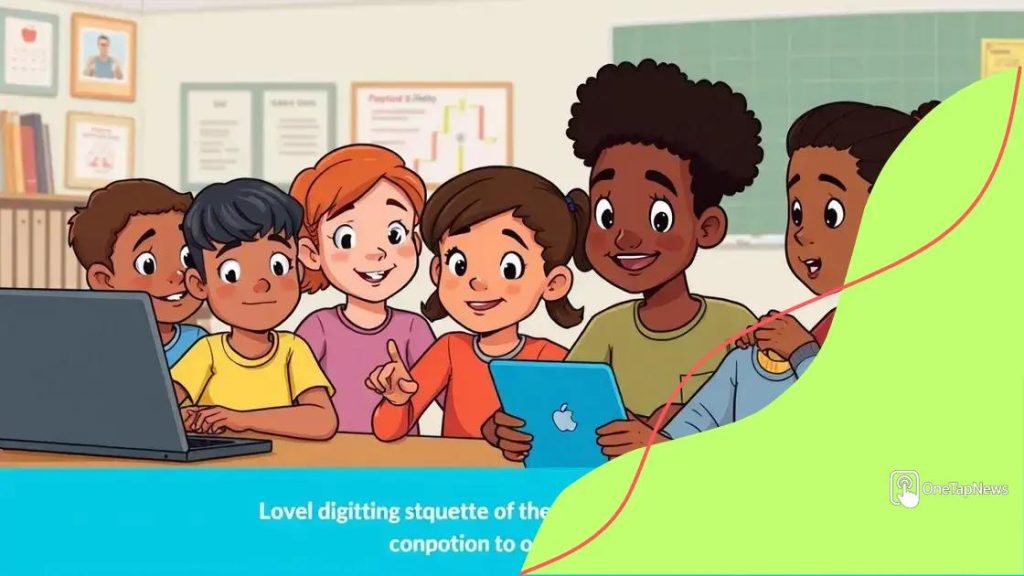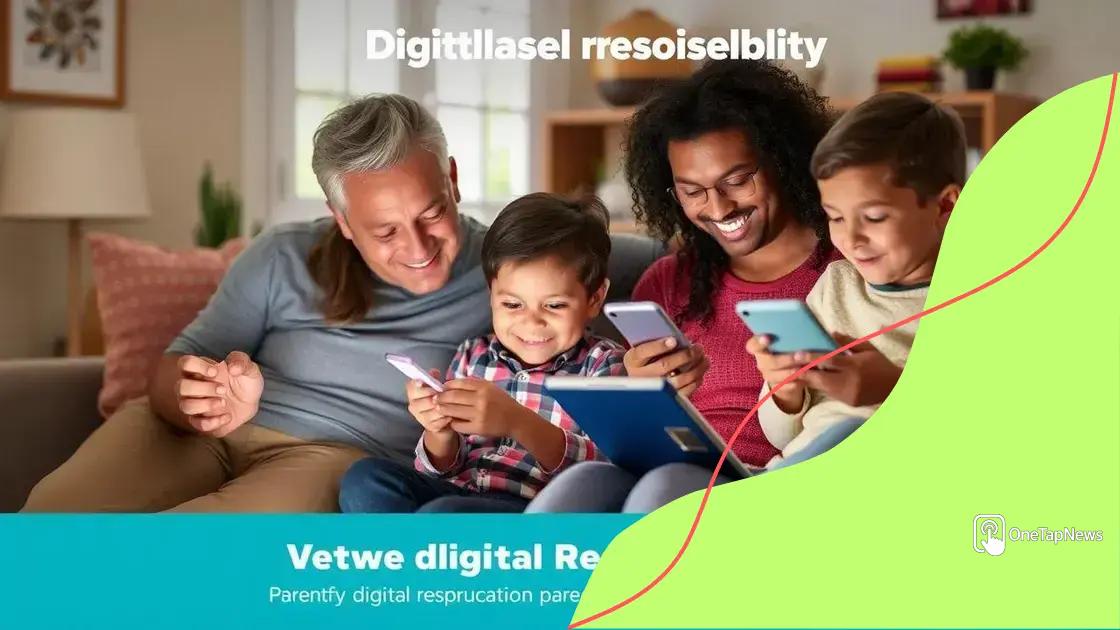Education in responsible digital behavior: a guide

Anúncios
Education in responsible digital behavior equips individuals, especially children, with essential skills to navigate online spaces safely, emphasizing emotional intelligence, privacy protection, and respectful interactions.
Education in responsible digital behavior is crucial in an age where our online actions shape real-world consequences. How do we navigate these digital waters safely? This article will explore the importance of understanding this behavior and offer actionable insights.
Anúncios
Understanding responsible digital behavior
Understanding responsible digital behavior is essential as our lives become increasingly intertwined with technology. Many people don’t realize the impact their online actions can have on themselves and others.
To grasp this concept, we need to look at several aspects of digital behavior.
The basic principles of responsible use
Responsible digital behavior encompasses guidelines that everyone should follow. Here are a few key points to consider:
Anúncios
- Think before you post: Always consider how your message can be perceived.
- Respect others’ privacy: Be cautious about sharing information that isn’t yours.
- Practice kindness: Online interactions should reflect empathy and respect.
- Stay safe: Use strong passwords and be aware of online scams.
These principles serve as the foundation for navigating online spaces responsibly. Knowing these concepts ensures that we all contribute to a safer digital environment.
The role of social media
Social media plays a significant role in shaping our digital interactions. It allows us to connect and share experiences but can also lead to negative behavior if misused. It’s crucial to recognize the potential risks and responsibilities that come with using these platforms.
Awareness of the effects of social media on mental health is essential. Spending too much time online can lead to feelings of isolation, anxiety, or even depression. It’s vital to set boundaries and take breaks when needed.
Promoting digital literacy
To encourage responsible behavior, digital literacy education is key. This involves teaching individuals of all ages how to navigate online spaces correctly. Understanding how to discern credible sources from unreliable ones can prevent misinformation.
Moreover, discussing the impact of their online footprint is essential. Each post or comment can leave a lasting mark, and understanding this can promote more thoughtful interactions.
In sum, responsible digital behavior is a shared responsibility. It involves understanding personal actions and their ripple effects on a broader community.
The impact of social media on our actions
The impact of social media on our actions is profound and far-reaching. As we engage with others online, it’s important to recognize how these platforms influence our behavior and mindset.
One major aspect is how social media can shape our perceptions. The images and messages we see daily contribute to our understanding of norms and expectations. Often, these representations may not reflect reality, leading to unrealistic standards.
Emotional effects of social media
Social media can have both positive and negative emotional effects. On one hand, it fosters connections and lets us share experiences with friends. On the other hand, it can lead to feelings of inadequacy and loneliness. It’s vital to be aware of these emotions to avoid negative self-comparisons.
- Connection: Social media helps us stay connected with friends and family.
- Validation: Likes and comments can create a sense of approval.
- Comparison: Seeing others’ curated lives can lead to unhealthy comparisons.
- Isolation: Excessive use can contribute to feelings of loneliness.
This duality illustrates the importance of managing our social media use. By setting healthy boundaries, we can enjoy connections while safeguarding our mental health.
Behaviors influenced by social media
Moreover, social media often influences our behaviors in significant ways. The desire for likes and shares can affect how we communicate and present ourselves online. This pressure may lead to changing opinions or actions just to fit in.
It’s essential to think critically about the content we consume and share. Engaging with positive and constructive material can help form healthier behaviors. When we actively seek out uplifting content, we create a more supportive online environment for ourselves and others.
As we reflect on the influence of social media, it’s clear that our actions are often shaped by the online world. Awareness and mindfulness in our interactions can lead to a more positive experience.
Tools for promoting digital responsibility

Using the right tools is essential for promoting digital responsibility. These resources help individuals and families navigate online spaces safely and effectively.
Various applications and platforms can enhance our understanding of responsible digital behavior. By utilizing these resources, we can educate ourselves and others about safe online practices.
Apps for digital well-being
Many apps are designed to promote digital responsibility by helping users monitor their online habits. Here are some valuable tools:
- Screen Time: This app allows users to set limits on app usage and track time spent on different activities.
- Circle: A device that helps manage internet access for all devices in the home, fostering healthy online habits.
- Net Nanny: A parental control software that helps monitor and manage children’s online activities.
- Internet Safety Apps: Various apps focus on teaching children about online safety and appropriate conduct.
By incorporating these tools into daily routines, families can foster a safer online environment.
Educational resources
In addition to apps, educational websites and programs provide crucial information about digital responsibility. Many organizations offer free resources designed to teach individuals of all ages about safe online practices.
Participating in workshops and online courses can also enhance understanding. Many of these programs focus on skills such as identifying fake news, understanding digital footprints, and maintaining cybersecurity.
By engaging with these educational resources, users can become more aware of their online actions and how they shape their digital lives.
Ultimately, leveraging the right tools and educational resources can promote a culture of digital responsibility. Awareness and proactive engagement are key to navigating the online world safely.
Teaching kids about online safety
Teaching kids about online safety is crucial in today’s digital age. As children engage more with technology, they need to learn how to navigate the online world responsibly.
It’s important to start with the basics. Kids should understand the importance of keeping personal information private. This includes not sharing details like their full name, address, or school online. By instilling this knowledge early on, children can become more aware of the risks involved in their online activities.
Essential topics to cover
When discussing online safety, it’s essential to cover several key topics:
- Recognizing safe websites: Teach kids how to identify trustworthy sites and look for signs of safety, such as secure URLs.
- Managing passwords: Explain how to create strong passwords and the importance of not sharing them with anyone.
- Respecting others: Discuss the importance of treating others online with kindness and understanding that their words can have real consequences.
- Reporting problems: Encourage kids to speak up if they encounter something uncomfortable or confusing and to talk to a trusted adult.
By covering these topics, children gain essential skills needed for safe interactions online. They learn that online safety is just as important as safety in the real world.
Practical strategies for parents
Parents can use practical strategies to reinforce online safety lessons. For example, setting up parental controls allows adults to monitor and limit what children can access online. This provides an added layer of security while children learn.
Additionally, engaging in conversations about their online experiences fosters openness. Regular discussions help ensure that children feel comfortable sharing their thoughts and concerns with their parents.
Encouraging kids to ask questions and discuss their online activities promotes a culture of safety and awareness. As children grow, they should feel empowered to make smart decisions in the digital space.
Future trends in digital behavior education
The landscape of digital behavior education is constantly evolving. As technology advances, new trends emerge that shape how we teach and learn about responsible online conduct.
One significant trend is the integration of technology into educational settings. Schools are increasingly using interactive tools and platforms to engage students. This not only makes learning fun but also helps to illustrate real-world applications of digital behavior concepts.
Gamification in learning
Gamification is becoming a popular method for teaching digital behavior. By using game-like elements, educators can motivate students to learn about online safety and responsibility. Here are some benefits of this approach:
- Increased Engagement: Students are more likely to participate in learning when it’s interactive and fun.
- Real-Life Scenarios: Games can simulate real-world challenges, allowing students to practice decision-making in a safe environment.
- Feedback Mechanisms: Immediate feedback helps students understand the consequences of their choices.
This hands-on approach makes digital behavior concepts more relatable and memorable for students.
Focus on emotional intelligence
Another trend is emphasizing emotional intelligence in digital interactions. Teaching kids to recognize their emotions and those of others can lead to more respectful and responsible online behavior. Educators are now incorporating lessons on empathy and communication skills. These lessons help students understand the impact of their digital actions on others, promoting a culture of kindness online.
As we move forward, the emphasis on social-emotional learning will play a vital role in equipping students to handle digital interactions sensitively and responsibly.
Overall, the future of digital behavior education lies in innovative teaching methods that resonate with students and prepare them for the complexities of the digital world.
In conclusion, teaching digital behavior is crucial for navigating the online world safely. As we move forward, incorporating innovative teaching methods, such as gamification and emotional intelligence, will play a vital role in engaging students. By using these strategies, we can prepare children to make responsible choices online. Together, we can create a more respectful and safe digital environment.
\n
\n
FAQ – Frequently Asked Questions about Digital Behavior Education
Why is digital behavior education important?
Digital behavior education is vital for helping individuals navigate the online world safely and responsibly, reducing the risk of negative interactions.
What are some effective teaching methods for digital behavior?
Gamification and emotional intelligence training are effective methods that engage students and teach them about responsible online interactions.
How can parents support their children’s online education?
Parents can discuss online experiences regularly, set up parental controls, and encourage open communication about digital interactions.
What role does emotional intelligence play in online safety?
Emotional intelligence helps children understand their own feelings and those of others, which fosters respectful interactions and reduces cyberbullying.